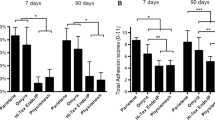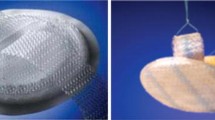Abstract
Background
In many cases, incisional hernia repair requires the use of prosthetic materials. The aim of this experimental study in a rat model was to assess the role of polyglactin 910 mesh and fluoropassivated polyester mesh in preventing the formation of adhesions.
Methods
In the first experiment, the formation of peritoneal adhesions was assessed after insertion of polypropylene, polypropylene combined with polyglactin 910, or no mesh. In the second experiment, adhesion formations were compared after insertion of fluoropassivated polyester, polypropylene, and no mesh.
Results
The first experiment showed no significant difference in adhesion formations between the polypropylene mesh and the combined mesh; however, when no mesh was used, there were significantly fewer adhesions in both experiments (p<0.01). The second experiment showed a significantly lower degree of adhesions and a lower Adhesion Index after insertion of fluoropassivated polyester mesh than when polypropylene mesh was used (p=0.04).
Conclusions
Adding polyglactin 910 mesh to polypropylene mesh to prevent the formation of adhesions is not an effective measure. Fluoropassivated polyester meshes appear to provide a better alternative to the use of polypropylene meshes for incisional hernia repair in humans in terms of the formation of adhesions.
Similar content being viewed by others
References
George CD, Ellis H (1986) The results of incisional hernia repair: a twelve-year review. Ann R Coll Surg Engl 68: 185–187
Hesselink VJ, Luijendijk RW, de Wilt JH, Heide R, Jeekel J (1993) An evaluation of risk factors in incisional hernia recurrence. Surg Gynecol Obstet 176: 228–234
Jenkins SD, Klamer TW, Parteka JJ, Condon RE (1983) A comparison of prosthetic materials used to repair abdominal wall defects. Surgery 94: 392–398
Kelso K, Blackett B (1977) Bacterial adherence to Prolene (Ethicon), Fluorosoft and Fluoromesh (Sulzer Vascutek). A product-comparison study on file at Sulzer Vascutek.
Langer S, Christiansen J (1985) Long-term results after incisional hernia repair. Acta Chir Scand 151: 217–219
Leber GE, Garb JL, Alexander AI, Reed WP (1998) Long-term complications associated with prosthetic repair of incisional hernias. Arch Surg 133: 378–382
Manninen MJ, Lavonius M, Perhoniemi VJ (1991) Results of incisional hernia repair; a retrospective study of 172 unselected hernioplasties. Eur J Surg 157: 29–31
Molloy RG, Moran KT, Waldron RP, Brady MP, Kirwan WO (1991) Massive incisional hernia: abdominal wall replacement with Marlex® mesh. Br J Surg 78: 242–244
Mudge M, Hughes LE (1985) Incisional hernia: a 10-year prospective study of incidence and attitudes. Br J Surg 72: 70–71
Soares BM, Guidoin RG, Marois Y, Martin L, King MW, Laroche G, Zhang Z, Charara J, Girard JF (1996) In vivo characterisation of a fluoropassivated gelatin-impregnated polyester mesh for incisional hernia repair. J Biomed Mat Res 32: 293–305
Thompson JN, Whawell SA (1965) Pathogenesis and prevention of adhesion formation. Br J Surg 52: 471–476
Turkcapar AG, Yerdel MA, Aydinuraz K, Bayar S, Kuterdem E (1998) Repair of midline incisional hernias using polypropylene grafts. Surg Today 28: 59–63
Van den Tol MP, Van Stijn I, Bonthuis F, Marquet RL, Jeekel J (1997) Reduction of intraperitoneal adhesion formation by use of nonabrasive gauze. Br J Surg 84: 1410–1415
Zühlke HV, Lorenz EMP, Straub EM, Savvas V (1990) Pathophysiologie und Klassifikation von Adhäsionen. Langenbecks Arch Chir Suppl II Verh Dtsch Ges Chir 345: 1009–1016
Author information
Authors and Affiliations
Additional information
Online publication: 22 August 2000
Rights and permissions
About this article
Cite this article
Vrijland, W.W., Bonthuis, F., Steyerberg, E.W. et al. Peritoneal adhesions to prosthetic materials. Surg Endosc 14, 960–963 (2000). https://doi.org/10.1007/s004640000180
Received:
Accepted:
Published:
Issue Date:
DOI: https://doi.org/10.1007/s004640000180




